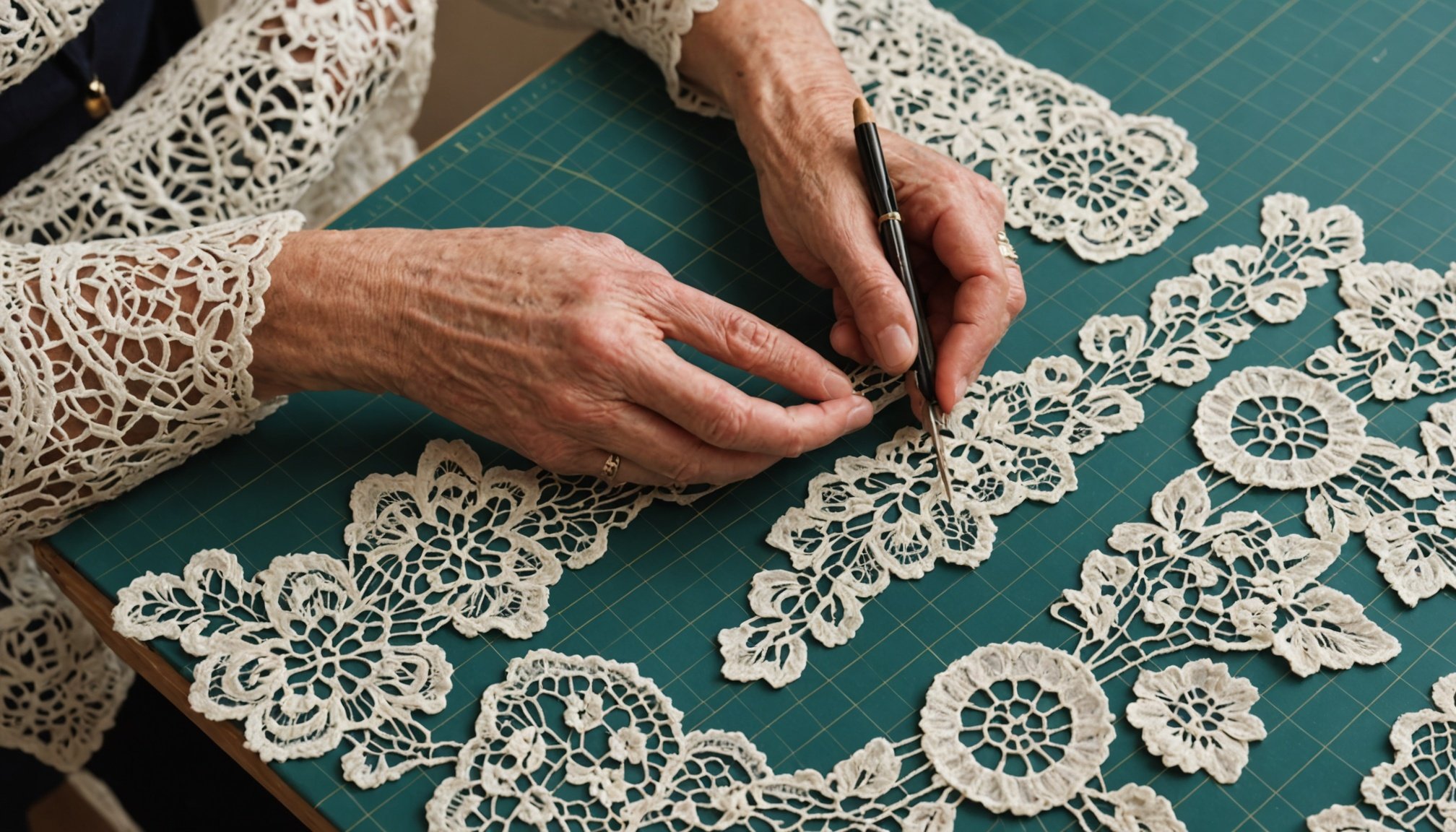Overview of British Lace Making
British lace making holds a rich tapestry in the fabric of cultural history. Originating in the 16th century, lace became a symbol of taste and status. This intricate art form, evolved through generations, showcases the dexterity and ingenuity of its crafters.
Honiton and Bedfordshire lace serve as prime examples of this traditional craft’s diversity. Honiton lace, from Devon, is famed for its delicate floral designs, achieved through individual motifs later assembled into a lace fabric. On the other hand, Bedfordshire lace, noted for its plaited designs and symmetrical patterns, originated in a county renowned for its lace since the 17th century.
Have you seen this : Explore Top UK Destinations with Guided Tours Revealing the Intriguing History of British Trade Unions
Over centuries, the techniques of lace making have significantly evolved. Initially made entirely by hand, the Industrial Revolution introduced machinery, altering production methods. Yet, traditional hand-crafting methods remain revered, embodying craftsmanship and preserving historical techniques.
Despite technological advances, the allure of handmade lace continues to inspire and captivate. It is not merely about aesthetics; lace making represents a comprehensive history of skill and an unbroken line of British craftsmanship that endures today. Engaging with this tradition helps keep a vibrant piece of cultural heritage alive.
Also to read : Discover Britain’s Top Lock-Making Workshops: A One-of-a-Kind Traditional Experience for Tourists
Types of Workshops Available
For those interested in immersing themselves in the art of lace making, a variety of workshops cater to different skill levels. These workshops offer valuable hands-on experience, allowing participants to delve into the meticulous craft of creating British lace.
Beginner workshops introduce participants to the basics, focusing on simple techniques and patterns to build foundational skills. Intermediate sessions cater to those with some understanding, introducing more complex designs and methods. Advanced workshops challenge experienced lace makers with intricate patterns and advanced techniques, pushing the boundaries of their craftsmanship.
Workshops are available across the UK, featuring esteemed locations known for rich lace history, such as Devon and Bedfordshire. Selecting a workshop that aligns with personal interests and skill level is crucial for a fulfilling experience. To do so, consider what you want to achieve and your current proficiency in lace making.
- Begin with beginner sessions if you’re new.
- Progress to intermediate and advanced workshops as your expertise grows.
Each offers a unique opportunity, enriching one’s understanding and appreciation of this traditional craft. Participants leave workshops not only with enhanced skills but also with a deeper connection to the cultural heritage of British lace making.
The Cultural Significance of Lace Making
British lace making is more than an art form; it is a vivid testament to cultural heritage and British craftsmanship. Originating centuries ago, this traditional craft has played a critical role in shaping local economies, particularly in regions renowned for lace making, such as Devon and Bedfordshire. As a cultural cornerstone, lace making attracts tourists keen to experience the depth of British traditions, fuelling local tourism and economic growth.
Efforts to preserve lace making techniques are imperative in maintaining this craft’s historical legacy. Cultural institutions frequently organise events and workshops, aiming to pass on intricate skills and deep knowledge to new generations. Through these initiatives, communities safeguard the craft against modern homogenization and technological advances.
Participating in lace making traditions allows individuals to connect with the past’s rich tapestry. The stories woven into the fabric speak of history, artistry, and enduring dedication to craftsmanship. By engaging with this heritage, enthusiasts contribute to the continuity of a craft that maintains an unbroken line in cultural significance. This dual role in preserving history and promoting skill makes the lace making tradition a cherished facet of British culture.
What to Expect from a Workshop
Participating in a lace making workshop is an immersive experience that blends creativity with tradition. When attending, expect a structured schedule that balances instruction with practical application. Typically, workshops commence with introductions, where instructors elaborate on the day’s objectives and outline the materials provided. These materials often include threads, bobbins, and lace pillows, ensuring you have everything necessary for a hands-on experience.
Instructors in these workshops are often seasoned artisans, bringing years of expertise to guide participants. Their teaching methods usually involve demonstrations, allowing you to observe techniques before trying them yourself. Expect a supportive environment, as instructors provide guidance tailored to your skill level, from beginners to advanced practitioners.
Most workshops run over several hours or days, featuring activities that gradually build your lace making skills. You will learn fundamental techniques and patterns, gradually advancing to more complex designs. Workshops accommodate varied skill levels, challenging and supporting each participant’s growth.
Overall, the instructor-guided workshop experience offers an invaluable opportunity to refine your abilities while embracing the rich tradition of British lace making. Through this journey, you’ll cultivate skills and confidence, leaving with both tangible creations and cherished memories.
Preparing for Your Lace Making Workshop
Embarking on a lace making workshop requires thoughtful preparation to enhance your hands-on experience. Bringing the right items can significantly impact your comfort and success during the session. While workshops typically provide essential materials like threads and bobbins, participants should consider bringing personal tools like comfortable scissors or a notebook for note-taking.
For newcomers, mental preparation plays a crucial role. Approach the learning process with an open mind and patience; lace making is a skill that blossoms over time. Familiarise yourself with basic terminology and techniques ahead of time, which will make learning during the workshop smoother.
Researching the history of British lace making before attending can amplify your appreciation for this traditional craft. Understanding the origins and evolution of the craft can inspire and motivate you, illustrating the depth of tradition you are about to engage with.
Finally, check the specific workshop’s guidelines for any additional recommendations. Some workshops might suggest attire that’s conducive to hands-on work, or extra materials not listed in their standard offer. Embracing these preparations can enrich your workshop experience, ensuring you leave with both newfound skills and a deeper connection to this historic art form.
Testimonials from Previous Participants
Diving into participant experiences from various workshops reveals insights into the enriching world of lace making. Reviews repeatedly highlight the satisfaction of learning hands-on techniques directly from skilled instructors. Participants often share how these experiences significantly enhanced their understanding of traditional crafts.
Feedback indicates that the structured environments of workshops cater to various skill levels, fostering both confidence and enthusiasm for the craft. Many attendees remark on the meticulous, encouraging guidance received, noting it as a pivotal factor in transitioning from novice to a more proficient lace maker.
Memorable experiences frequently revolve around the artistic breakthroughs achieved during sessions. Participants often describe the moment they successfully completed their first intricate design as profoundly rewarding. The collective, supportive atmosphere further amplifies this satisfaction, as peers and instructors celebrate these achievements together.
Participants often mention their increased appreciation for the history of lace as a significant takeaway. Engaging with the cultural depth of British lace making adds a rich layer to their newly acquired skills. Quotes encapsulate the essence of these workshops, reflecting on how personal growth and a deeper connection to this timeless craft were the ultimate rewards.







